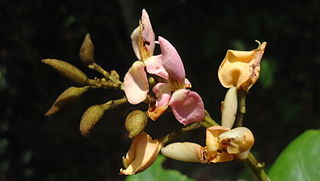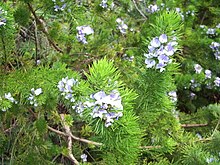
The Faboideae are a subfamily of the flowering plant family Fabaceae or Leguminosae. An acceptable alternative name for the subfamily is Papilionoideae, or Papilionaceae when this group of plants is treated as a family.

Psoralea is a genus in the legume family (Fabaceae) with 111 species of shrubs, trees, and herbs native to southern and eastern Africa, ranging from Kenya to South Africa. In South Africa they are commonly referred to as fountainbush (English); fonteinbos, bloukeur, or penwortel (Afrikaans); and umHlonishwa (Zulu).

The plant tribe Phaseoleae is one of the subdivisions of the legume subfamily Faboideae, in the unranked NPAAA clade. This group includes many of the beans cultivated for human and animal food, most importantly from the genera Glycine, Phaseolus, and Vigna.

Camoensia is a genus of 2 species of lianas in the family Fabaceae, subfamily Faboideae, native to the Gulf of Guinea, Africa. C. scandens is cultivated as an ornamental plant; it has one of the largest leguminous flowers, up to 20 cm across. The genus has classically been assigned to the tribe Sophoreae, but was recently assigned to its own monophyletic tribe, Camoensieae, on the basis of molecular phylogenetic evidence. Species of Camoensia are known to produce quinolizidine alkaloids, consistent with their placement in the genistoid clade.

Otholobium is a genus of flowering plants in the pea family with over 50 named species, but several also remain undescribed so far. Species may be herbaceous perennials, subshrubs, shrubs or small trees. The alternately set leaves are accompanied by stipules and mostly consist of three leaflets, sometimes just one. The inflorescences are on short or long stalks in the axils of the leaves. Within the inflorescences, the pea-like flowers occur in groups of three, rarely of two, subtended by a bract, and each individual flower also is subtended by a narrow bract. The petals may be white, pink, purple or blue, often with a differently colored nectar guide, that may sometimes even be yellow. The seedpods contain just one, black, dark or light brown seed. Most species are restricted to the Cape provinces of South Africa, but some occur at higher elevations in eastern Africa. Charles Stirton erected the genus in 1981. The species in South America will probably be segregated, because these are not sufficiently related to the African species.

Galegeae is a tribe in the flowering plant family Fabaceae, subfamily Faboideae. The tribe is found mostly in the northern hemisphere, but can also be found in Australia, Africa, and South America. Recent molecular phylogenetic work has determined that tribe Galegeae is paraphyletic, and that its members are scattered throughout the IR-lacking clade.

Crotalarieae is a tribe of flowering plants belonging to the family Fabaceae. It includes rooibos (Aspalathus linearis), which is harvested for sale as a tisane.

Cercidoideae is a subfamily in the pea family, Fabaceae. Well-known members include Cercis (redbuds), including species widely cultivated as ornamental trees in the United States and Europe, Bauhinia, widely cultivated as an ornamental tree in tropical Asia, and Tylosema, a semi-woody genus of Africa. The subfamily occupies a basal position within the Fabaceae and is supported as monophyletic in many molecular phylogenies. At the 6th International Legume Conference, the Legume Phylogeny Working Group proposed elevating the tribe Cercidae to the level of subfamily within the Leguminosae (Fabaceae). The consensus agreed to the change, which was fully implemented in 2017. It has the following clade-based definition:
The most inclusive crown clade containing Cercis canadensisL. and Bauhinia divaricataL. but not Poeppigia proceraC.Presl, Duparquetia orchidaceaBaill., or Bobgunnia fistuloides(Harms) J.H.Kirkbr. & Wiersema.
Polhillia is a genus of flowering plants in the family Fabaceae. It includes 11 species of shrubs and herbs native to the Cape Provinces of South Africa. They grow in Mediterranean-climate renosterveld (shrubland) and scrub-grassland, typically in heavy soils. The genus belongs to subfamily Faboideae.

The tribe Amorpheae is an early-branching clade within the flowering plant subfamily Faboideae or Papilionaceae. It is found from Mexico to Argentina. It was recently found to belong in a larger clade known informally as the dalbergioids sensu lato. This tribe is consistently resolved as monophyletic in molecular phylogenetic analyses. It is estimated to have arisen 36.9 ± 3.0 million years ago. A node-based definition for Amorpheae is: "the MRCA of Psorothamnus arborescens and Eysenhardtia orthocarpa." The tribe exhibits the following morphological synapomorphies: "epidermal glands throughout the plant body; dry, indehiscent fruits that are single-seeded; and terminal inflorescences."

The tribe Brongniartieae is one of the subdivisions of the plant family Fabaceae, primarily found in tropical regions of the Americas and in Australia The members of this tribe consistently form a monophyletic clade in molecular phylogenetic analyses. The tribe does not currently have a node-based definition, but morphological synapomorphies have been identified:
"stamens united by filaments in an adaxially open tube; anthers alternately long and basifixed, short and versatile; anther connective inconspicuous; septa present between seeds in pods; aril lateral lobe present and fitting into heel of funicle; fine red glandular processes present in axils; and pollen tricolporate with opercula and no definite endoaperture."

The tribe Podalyrieae is one of the subdivisions of the plant family Fabaceae.

The tribe Sophoreae is one of the subdivisions of the plant family Fabaceae. Traditionally this tribe has been used as a wastebasket taxon to accommodate genera of Faboideae which exhibit actinomorphic, rather than zygomorphic floral symmetry and/or incompletely differentiated petals and free stamens. Various morphological and molecular analyses indicated that Sophoreae as traditionally circumscribed was polyphyletic. This led to a re-circumscription of Sophoreae, which resulted in the transfer of many genera to other tribes. This also necessitated the inclusion of two former tribes, Euchresteae and Thermopsideae, in the new definition of Sophoreae. Tribe Sophoreae, as currently circumscribed, consistently forms a monophyletic clade in molecular phylogenetic analyses. The Sophoreae arose 40.8 ± 2.4 million years ago.

The tribe Exostyleae is an early-branching monophyletic clade of the flowering plant subfamily Faboideae that are mostly found in Neotropical rainforests.
The tribe Ormosieae is one of the subdivisions of the plant family Fabaceae, primarily found in tropical regions of the Americas, but also in southeast Asia and northern Australia. The members of this tribe were formerly included in tribe Sophoreae, but were recently circumscribed into a new tribe. The members of this tribe consistently form a monophyletic clade in molecular phylogenetic analyses. The tribe does not currently have a node-based definition, but morphological synapomorphies have been tentatively identified: "mostly dehiscent pods with woody valves" and "tufts of minute colleter-like glands in the axils of bract and bracteoles". Like other genistoids, members of tribe Ormosieae are known to produce quinolizidine alkaloids.

The Genistoids are one of the major radiations in the plant family Fabaceae. Members of this phylogenetic clade are primarily found in the Southern hemisphere. Some genera are pollinated by birds. The genistoid clade is consistently resolved as monophyletic in molecular phylogenetic analyses. It is estimated to have arisen 56.4 ± 0.2 million years ago. A node-based definition for the genistoids is: "the MRCA of Poecilanthe parviflora and Lupinus argenteus." One morphological synapomorphy has been tentatively identified: production of quinolizidine alkaloids. Some genera also accumulate pyrrolizidine. A new genus, to be segregated from Clathrotropis, has also been proposed to occupy an undetermined position within the genistoid clade.

The dalbergioids are an early-branching monophyletic clade of the flowering plant subfamily Faboideae or Papilionaceae. They are pantropical, particularly being found in the neotropics and sub-Saharan Africa. This clade is consistently resolved as monophyletic in molecular phylogenetic analyses. It is estimated to have arisen 55.3 ± 0.5 million years ago. A node-based definition for the dalbergioids is: "The least inclusive crown clade that contains Amorpha fruticosaL. 1753 and Dalbergia sissooRoxb. ex DC. 1825." Indehiscent pods may be a morphological synapomorphy for the clade.

The Mirbelioids are an informal subdivision of the plant family Fabaceae that includes the former tribes Bossiaeeae and Mirbelieae. They are consistently recovered as a monophyletic clade in molecular phylogenies. The Mirbelioids arose 48.4 ± 1.3 million years ago. Members of this clade are mostly ericoid (sclerophyllous) shrubs with yellow and red flowers found in Australia, Tasmania, and Papua-New Guinea. The name of this clade is informal and is not assumed to have any particular taxonomic rank like the names authorized by the ICBN or the ICPN. Members of this clade exhibit unusual embryology compared to other legumes, either enlarged antipodal cells in the embryo sac or the production of multiple embryo sacs. There has been a shift from bee pollination to bird pollination several times in this clade. Mirbelioids produce quinolizidine alkaloids, but unlike most papilionoids, they do not produce isoflavones. Many of the Mirbelioids have pseudoraceme inflorescences.

The subfamily Dialioideae is one of the subdivisions of the plant family Fabaceae (legumes). This subfamily includes many tropical trees and shrubs. The subfamily consists of 17 genera, which are widespread throughout the tropics. It has the following clade-based definition:
The most inclusive crown clade containing Poeppigia proceraC.Presland Dialium guianense(Aubl.) Sandwith, but not Cercis canadensisL., Duparquetia orchidaceaBaill., or Bobgunnia fistuloides(Harms) J. H. Kirkbr. & Wiersema

















